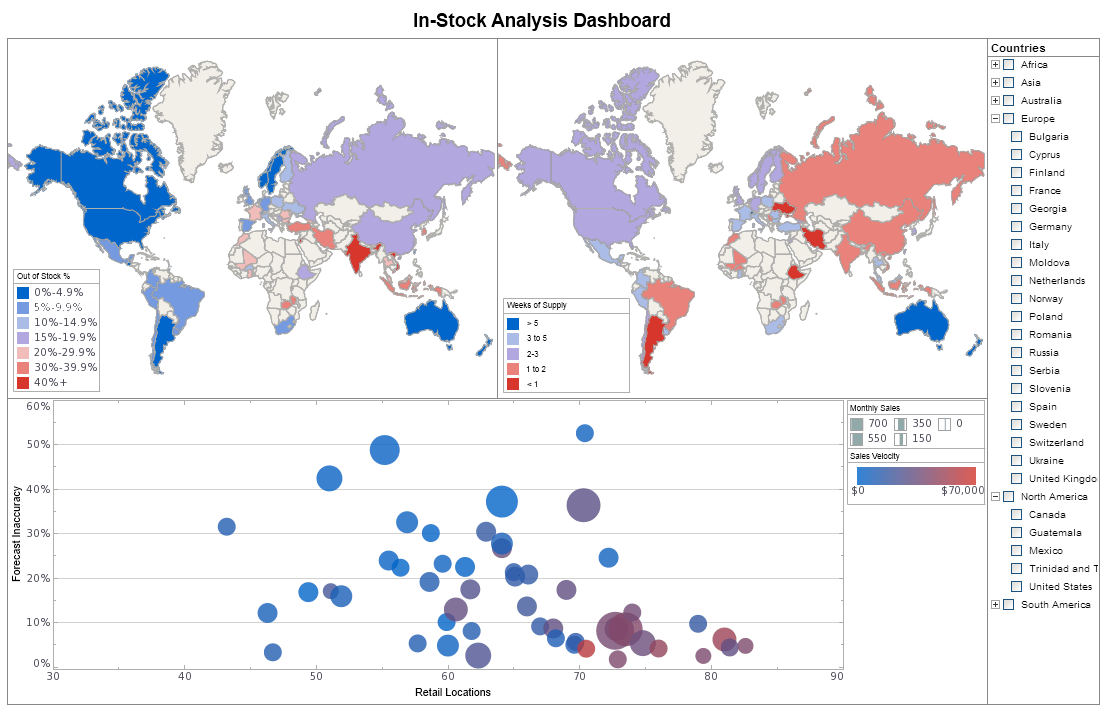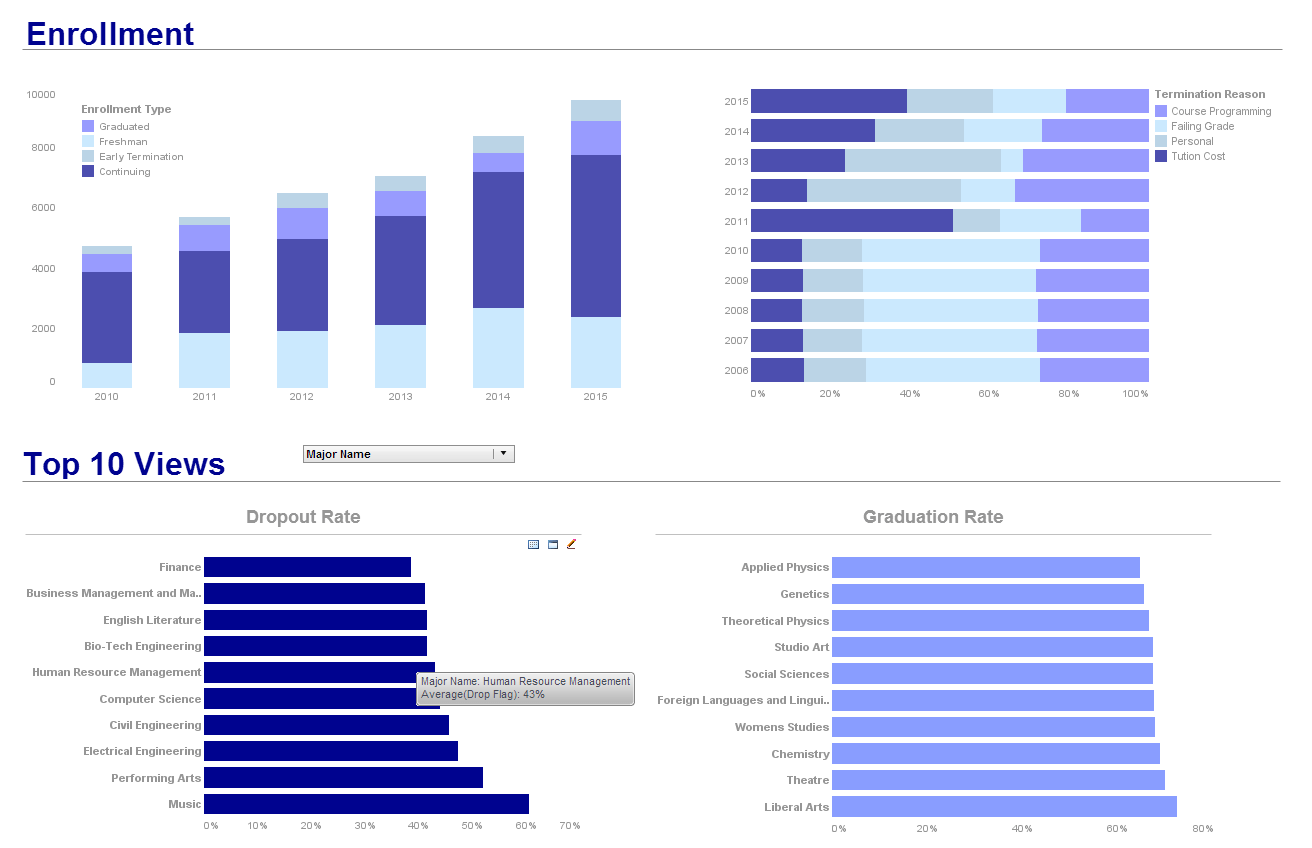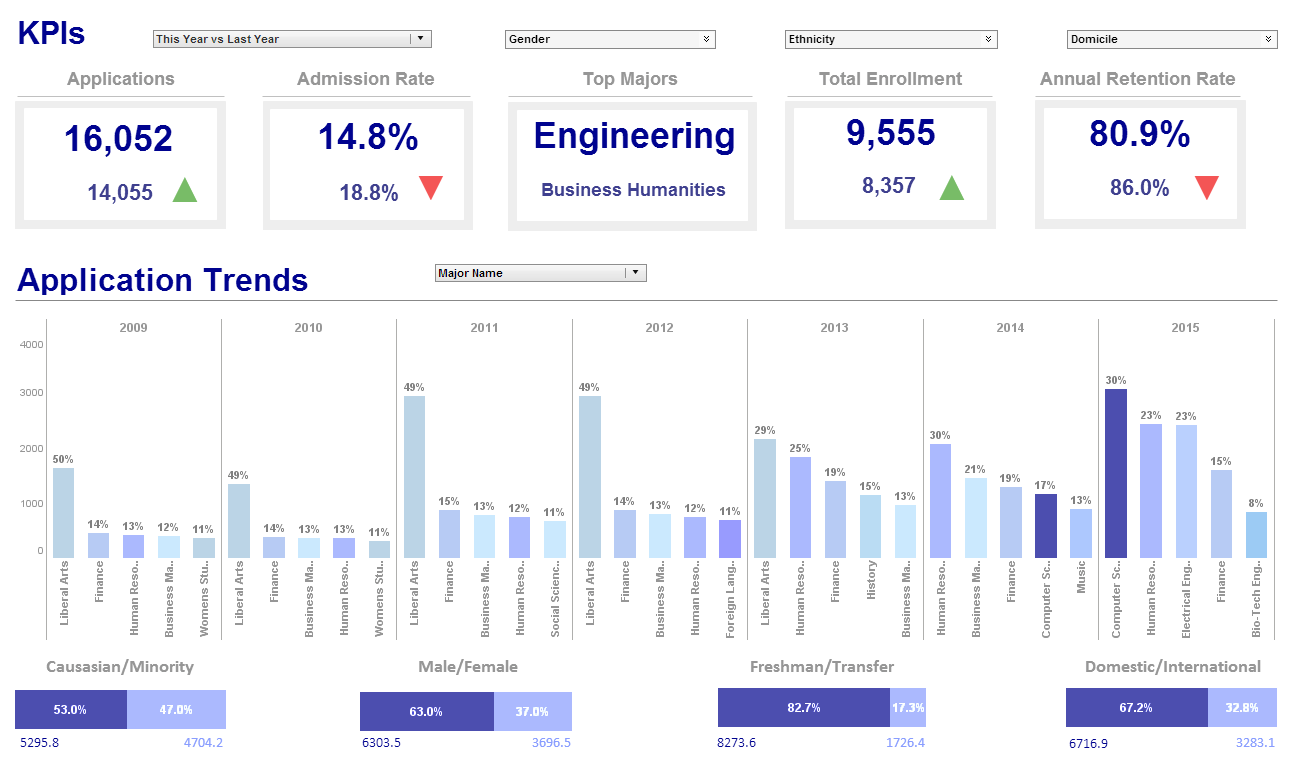Try InetSoft's Dashboard Solution in 2025
Are you looking for the best dashboard solution? Since 1996 InetSoft has been making dashboard software that is easy to deploy and easy to use. Its unique data mashup capabilities enable unified views of corporate performance and maximum self-service.

Why InetSoft?
InetSoft's performance dashboard application is easy enough to be:
- Deployed in just weeks
- Learned by end users with minimal training
- Used by any executive without the aid of IT
agile enough to be:
- Adaptable to changing data and business needs
- Used for data exploration through visualization
- Capable of maximum self-service
and robust enough to:
- Attract the attention of executives
- Meet the demands of power users
- Scale up for organizations of any size
Evaluate StyleBI from InetSoft. It's Easy. Agile. & Robust.
Register for more info and to download free eval software
| #1 Ranking: Read how InetSoft was rated #1 for user adoption in G2's user survey-based index | Read More |
How Content Marketing Managers Use Dashboards
Content Marketing Managers use dashboards as a powerful tool to keep track of their marketing campaigns and to measure their success. Dashboards are visual representations of data that provide managers with a quick overview of their marketing metrics in real-time. By using dashboards, Content Marketing Managers can access valuable insights that enable them to make informed decisions about their marketing strategies, improve their campaigns, and achieve their marketing goals.
One of the most important ways that Content Marketing Managers use dashboards is to monitor the performance of their marketing campaigns. Dashboards provide an at-a-glance view of various metrics, including website traffic, social media engagement, email marketing performance, and other important KPIs. By monitoring these metrics in real-time, managers can quickly identify any issues or areas of improvement in their marketing campaigns and make necessary adjustments.
Content Marketing Managers also use dashboards to track the success of their content marketing initiatives. They can monitor the performance of individual pieces of content, including blog posts, videos, infographics, and other formats, and see how they are resonating with their target audience. By measuring the success of their content marketing initiatives, managers can identify which types of content are most effective and adjust their content strategy accordingly.
Another way that Content Marketing Managers use dashboards is to evaluate the ROI of their marketing efforts. They can track the costs associated with their marketing campaigns and compare them to the revenue generated. By measuring the ROI of their marketing efforts, managers can determine which campaigns are most effective and allocate their marketing budget accordingly.
Dashboards also provide Content Marketing Managers with the ability to collaborate and share information with other team members. By sharing dashboards with team members, managers can ensure that everyone is on the same page and working towards the same goals. Dashboards can also be customized to show specific metrics and data that are relevant to different team members, making it easier to collaborate and communicate effectively.
What KPIs Do Content Marketing Managers Use?
Content Marketing Managers use Key Performance Indicators (KPIs) to measure the success of their marketing campaigns and to identify areas for improvement. KPIs are specific metrics that help managers track progress towards their marketing goals, and they vary depending on the specific objectives of each campaign.
One of the most important KPIs for Content Marketing Managers is website traffic. This metric measures the number of visitors to a website and is an indicator of the effectiveness of a marketing campaign in driving traffic. Managers can use website traffic KPIs to measure the success of different marketing channels, such as search engine optimization, social media, and email marketing, and to identify areas for improvement.
Another important KPI is lead generation. This metric measures the number of leads that are generated from a marketing campaign and is a critical measure of the effectiveness of a campaign in driving business growth. Content Marketing Managers can use lead generation KPIs to track the success of their campaigns in generating new leads and to identify areas where they can improve their lead generation efforts.
Content Marketing Managers also use engagement KPIs to measure how users are interacting with their content. This includes metrics such as social media likes, shares, and comments, as well as website engagement metrics such as time on page and bounce rate. Engagement KPIs help managers understand how users are engaging with their content and can help them make improvements to increase user engagement and build brand loyalty.
Another important KPI is conversion rates. This metric measures the percentage of users who take a desired action, such as filling out a form or making a purchase, and is a key indicator of the effectiveness of a marketing campaign in driving conversions. Content Marketing Managers can use conversion rate KPIs to track the success of their campaigns in driving conversions and to identify areas where they can improve their conversion rates.
Finally, Content Marketing Managers use ROI KPIs to measure the return on investment of their marketing campaigns. This includes metrics such as revenue generated, cost per lead, and cost per acquisition. ROI KPIs help managers determine the effectiveness of their campaigns in driving business growth and can help them allocate their marketing budget more effectively.
 |
View live interactive examples in InetSoft's dashboard and visualization gallery. |
More Articles About Dashboard Usage Advice
Benefits of Patient Care Reports - It is commonly used by emergency medical services (EMS) providers, such as paramedics and emergency medical technicians (EMTs), to document the treatment and care given to a patient while being transported to a hospital or other medical facility. Maintaining accurate and detailed patient care documentation has various advantages: The facilities of a healthcare institution are what makes the patients rely on them with trust. So, managing those facilities is a must and you can do it better with the help of patient care reports. It will give insight into how the patients are enjoying and benefiting from the hospital...
The Cost of Bad Data - I think businesses have long had difficulty quantifying the cost of bad data other than to suffer the consequences of the problem. It's clear that incorrect customer data leads to missed opportunities for cross-sell and up-sell of existing customers as well as inefficient methods of finding new customers and increases the chances that you are going to irritate all your customers through incorrect billing, poorly-aimed marketing and other problems...
Do We Need to Change the Analytics? - Are the changes working for us? Do we need to change the analytics themselves? Are we measuring the wrong things? Are we using the right words with customers? Are we training our people correctly? The latest thing that we are seeing, and it's obvious because of the financial crisis around the world, is risk management. All of the CXOs are concerned in one or another way in their industry about capital investment, risk management, employee utilization, productivity, and customer revenue. It's all tied together...
How to Create A Top-Notch Executive Dashboard - These guidelines might help you create an executive dashboard that is suitable for your team. If you want to create a dashboard that helps you lead effectively, you must know what data to present and how to display it. Name your target audience. You'll assist a certain audience inside your firm using the important KPIs on your executive dashboard. If you're a project manager, for instance, your data sets could pertain exclusively to your teams' projects. Choosing the audience, you want your data to serve is the first step in creating an executive dashboard. As a result, you'll be able to customize your dashboard for that audience and make the best selections possible...
 |
Read how InetSoft saves money and resources with deployment flexibility. |
How To Manage Very Complex Data Sets - Understanding how to manage these very complex data sets as well as how to analyze them is something that organizations are spending a lot of time in the pilot stage. They are working it out, and as they move into implementation and begin rolling this out across their organization what they saw is now the question of the data quality. They work to make sure that that data is integrated and understand the inherent imprecision in certain data types. I will say that the fact that that obstacle is not showing up until organizations are really moving from pilot to implementation is a bit troubling...
Make Your Dashboards Look As Nice As Possible - I certainly agree a lot of your points there, the idea of getting help to make your dashboards look as nice as possible. It's just a brilliant idea. Involving the various groups, getting collaboration and getting agreement ahead of time and helping, that works out. Do you review the performance management dashboards on an ongoing basis, and learn from that in order to apply improvements to them? Even the idea of aiming towards the average for underperformers is smart because as everybody gets better the target keep raising higher automatically...
Performance Management More Strategic - The historical reasons for using BI were to disseminate information. Now companies are thinking about performance metrics and performance management more strategically. Everybody is creating management dashboards. That creates a higher visibility for today's BI technologies, but there are places where you can get even higher ROI. The highest ROI on a BI project is down in the operational areas. Especially those areas that link out to the supply chain, or the customer directly. So call center metrics are extremely important. One of our major insurance industry customers just went through a major initiative to gather all these metrics and disseminating the data through dashboards so that from management to the call center reps, anyone who interacts with a customer, can see all the customer-related activity measurements...
 |
Learn about the top 10 features of embedded business intelligence. |
Powerful Healthcare KPIs - Now that you're up to speed with the undeniable power and benefits of working with healthcare KPIs, let's look at the types of metrics that could help your institution thrive, even under the most pressured of circumstances. A key operational healthcare metric, this financially-centric KPI will help you calculate the average cost of administering treatment per patient. Tracking this metric regularly will help you uncover any glaring financial inefficiency early and develop targeted strategies that get to the root of the issue and provide a better level of patient care for less...
Types of Analytics - Before going into the different ways of analyzing data, it is important to understand the fundamental types of analytics. The most common types are descriptive and prescriptive, but there are other categories as well. As more varieties of data analysis are understood, more value and actionable insights are brought to an organization...
Why StyleBI Over Other Solutions - Style Intelligence allows you to combine fields from disparate data sources, providing an efficient way to create a single source of information. The Data Block technology enables a high performance data mashup across domains and multiple data sources. The intuitive and visually interactive dashboards created using InetSoft's drag-and-drop viewsheet enhance the number of actionable insights that can be discovered. A wide range of sophisticated chart types, including custom geographic mapping, allow unlimited flexibility in dashboard creation...


